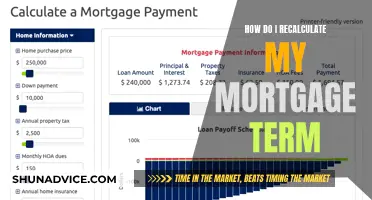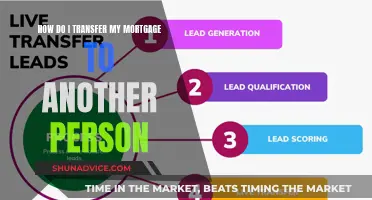
If you're looking to lower your monthly mortgage payments, you may want to consider resetting your mortgage. Also known as recasting or re-amortizing the loan, this option can help you reduce your monthly payments without going through the hassle and costs of refinancing. Here's what you need to know about resetting your mortgage and how it can benefit you.
| Characteristics | Values |
|---|---|
| What is a mortgage reset? | Also known as recasting the mortgage or re-amortizing the loan, a mortgage reset is a strategy for reducing your monthly payments. |
| When does it make sense? | When you have a large amount of money to put toward your loan but are unsure how your income will change in the future. |
| When does it not make sense? | If you do not have a large lump sum to invest, or if you plan to move in the next couple of years. |
| What do I need to reset my mortgage? | Homeowners will need to provide an upfront principal payment to kick off the recasting or resetting process. |
| How much can I save? | The amount you save depends on how much you owe on the house, the length of your remaining mortgage, and the size of the lump sum you have available. |
| What are the advantages? | Recasting is less expensive and comes with no credit or appraisal requirements. You can also keep your current interest rate. |
| What are the disadvantages? | You will be charged servicing fees. |
| What is the process? | The homeowner makes a large lump-sum payment to the lender, the lender reamortizes the balance, and the lender charges servicing fees. |
| What is the difference between a mortgage reset and a refinance? | A mortgage reset does not require you to apply for a new loan, whereas a refinance does. |
| What is the difference between a mortgage reset and a refinance in terms of interest rates? | A recast can allow you to keep your interest rate, whereas with a refinance, you usually have to accept the current market rate. |
| What is the difference between a mortgage reset and a refinance in terms of cost? | Recasting is less expensive than refinancing. |
| What is a rate reset mortgage loan? | A rate reset mortgage loan permanently reduces your interest rate, as well as the remaining principal and interest payments on your loan, without modifying any terms contained in your loan documents. |
What You'll Learn

Make a lump-sum payment to lower the principal balance
Making a lump-sum payment to lower the principal balance of your mortgage can be a great way to save money on interest and own your home outright sooner. This option is particularly appealing if you have a large amount of money to put towards your loan but are unsure how your income might change in the future.
When you make a lump-sum payment, the principal balance of your mortgage decreases. This reduction means you'll pay less interest over the life of the loan, potentially saving you thousands of dollars. Additionally, it can lead to lower monthly payments or a shortened loan term. For example, if you're five years into a 30-year mortgage with a $500,000 balance remaining and an annual percentage rate (APR) of 3.5%, a $10,000 lump-sum payment would shave off 10 months and $13,500 in interest from your original payment plan.
Before making a lump-sum payment, it's important to check with your lender to ensure there are no prepayment penalties and confirm that your extra payments will be applied to your principal balance rather than towards interest. It's also worth considering the opportunity cost of using your extra cash to pay down your mortgage early instead of investing it elsewhere. While you'll save on a portion of the interest expense, you may be better off investing the money elsewhere, especially if your interest rate is low.
Most lenders require the borrower to pay a minimum amount towards the principal before qualifying for a recast, usually $10,000, though it can also be a percentage of the principal. Additionally, some lenders require you to have a history of on-time payments before you can recast. Mortgage recasting, or re-amortization, is when a lender adjusts the repayment schedule to reflect a new, lower monthly due after a homeowner makes a large lump-sum payment. This process typically only requires a small administrative fee, usually between $150 and $500, and allows you to keep your current interest rate.
Registering a Mortgage in QLD: What You Need to Know
You may want to see also

Recast your mortgage to save money
Recasting your mortgage is a way to reduce your monthly payments and save money. It involves making a large lump-sum payment towards the principal balance of your loan, which then reduces the amount you owe. The lender will then reamortize the remaining balance, adjusting the repayment schedule to reflect the new monthly dues.
The specifics of a mortgage recast can vary by lender, but there are some general steps and requirements that are common across lenders. Most lenders require a minimum lump-sum payment of $10,000, though this can also be a percentage of the principal balance, usually up to 10%. Some lenders may also require that you have a history of on-time payments and a certain amount of equity in your loan before you qualify for a recast. It is important to note that not all lenders offer mortgage recasting, and some loan types, such as FHA and VA loans, are typically ineligible for recasting.
One of the main advantages of mortgage recasting is that it allows you to keep your current interest rate, which can be beneficial if you have a low interest rate on your mortgage. Recasting also does not require you to apply for a new loan, and there are no credit score or appraisal requirements. Additionally, the cost of recasting is typically much cheaper than refinancing, with fees ranging from $150 to $500.
However, it is important to consider the potential disadvantages of mortgage recasting. Firstly, it will not save you money on interest, and you will not be able to access your home's equity until you refinance or get a home equity loan. Additionally, while your monthly payments will decrease, the term length of your loan will remain the same. Therefore, it is crucial to evaluate your financial circumstances and consider seeking professional advice before deciding whether mortgage recasting is the right choice for you.
Paying Off Your Chase Mortgage: Strategies for Success
You may want to see also

Reduce your interest rate
Resetting your mortgage, also known as recasting the mortgage or re-amortizing the loan, is a strategy for reducing your monthly payments. It involves making a large lump-sum payment towards the principal balance of your loan, which then reduces the amount you owe. This strategy can be particularly effective when interest rates are low.
Improve Your Credit Score
A higher credit score can make you eligible for lower interest rates. You can improve your credit score by maintaining a low credit utilization ratio, paying your bills on time, and keeping older accounts open.
Shop Around for Lenders
Different lenders offer different interest rates, so it's worth shopping around to find the best deal. Compare the interest rates offered by various financial institutions, including banks, credit unions, and online lenders.
Negotiate with Lenders
When you have found a lender with a competitive interest rate, you can try negotiating for an even lower rate. Ask if they can match or beat the rates offered by their competitors. Inquire about any promotions or discounts they may offer, such as buying down your rate or float-down options, which allow you to pay a fee to reduce your rate if market rates fall.
Make a Larger Down Payment
A larger down payment reduces the lender's risk and can often qualify you for a lower interest rate. This strategy is especially effective if you plan to stay in the home long enough to reach the breakeven point, where the savings from the lower interest rate outweigh the cost of the larger down payment.
Buy Mortgage Discount Points
Some lenders offer the option to buy mortgage discount points, which directly lower your interest rate. Each point typically costs 1% of your loan amount and reduces your interest rate by 0.25%. However, calculate whether this option is financially beneficial for you, as the math does not always add up.
Monitor Market Rates and Lock Your Rate
Keep an eye on market rates, and if they are trending downwards, consider locking in a lower interest rate. Monitor rates daily and work with your loan officer to time your rate lock properly.
Remember that the effectiveness of these strategies may depend on various factors, including the economic climate, your financial situation, and the terms offered by lenders. It is always a good idea to consult with a financial professional before making any significant decisions regarding your mortgage.
Removing Someone from Your Mortgage: A Step-by-Step Guide
You may want to see also

Lower your monthly payments
Lowering your monthly mortgage payments can be done in several ways. One option is to refinance your current home loan, which involves replacing your current mortgage with a new one that has a lower interest rate. However, refinancing can be a lengthy and costly process, involving closing costs, nuisance charges, and other fees.
A less well-known but potentially beneficial option is to reset or recast your mortgage. This involves making a large lump-sum payment towards the principal balance of your loan, typically a minimum of $10,000, and then reamortizing the remaining balance. With reamortization, your interest rate and repayment term remain the same, but your monthly payments are lowered as the principal amount has reduced. This option can be particularly useful if you have recently sold a previous home and have cash available to put towards your current mortgage.
Another option to lower your monthly payments is to take advantage of specific programs, such as the IRRRL program offered by the Department of Veterans Affairs (VA) for eligible military borrowers. This program allows borrowers to refinance without a credit review, income verification, or appraisal, and closing costs can be added to the loan. Similarly, the USDA offers a streamline refinance option for low- and moderate-income borrowers in rural areas, which also does not require a credit review, income verification, or appraisal.
It is important to carefully consider your financial situation and seek professional advice before making any decisions regarding your mortgage. The right option for you will depend on various factors, including your available cash reserves, the length of your remaining mortgage, and the size of the lump sum you can afford to pay.
Recording a Mortgage in QuickBooks: A Step-by-Step Guide
You may want to see also

Avoid foreclosure
Resetting your mortgage, also known as recasting, can be a great way to save money on your monthly payments. However, it is not always the best option for everyone. If you are facing foreclosure, there are other steps you can take to avoid losing your home.
Firstly, it is important to act early. Do not wait until you are unable to make payments before seeking help. Contact your lender as soon as you know you are facing financial difficulties. They will be able to advise you on foreclosure prevention options and work with you to create a financial plan. You can also seek free or low-cost housing counselling from a HUD-approved agency, which can provide valuable information about your options.
In addition, the Federal Housing Administration (FHA), part of the U.S. Department of Housing and Urban Development (HUD), offers a range of loss mitigation programs and resources to assist homeowners facing financial hardship. These include the Making Home Affordable (MHA) Program, which helps lower monthly mortgage payments and get homeowners into more stable loans.
It is also worth noting that lenders do not want to repossess your house. They will often have options to help borrowers through difficult financial times, so be sure to open and read all mail from your lender, as this will contain important information about foreclosure prevention and any pending legal action.
Finally, be wary of scams. Many companies will offer to negotiate with your lender for a fee, but this is often unnecessary, as your lender or a HUD-approved housing counsellor can provide the same services for free.
Prepaying Your Mortgage: Strategies for Financial Freedom
You may want to see also
Frequently asked questions
A mortgage reset, also known as recasting the mortgage or re-amortizing the loan, is a way to reduce your monthly payments. It involves making a large lump-sum payment towards the principal balance of your loan, which then reduces the amount you owe. The lender will then adjust the repayment schedule to reflect the new balance.
The amount you can save depends on several factors, including how much you owe on the house, the length of your remaining mortgage, and the size of the lump sum you pay. Generally, the higher the lump sum payment, the more you can save.
A mortgage reset can be a good option if you have a large amount of money to put towards your loan but are unsure how your income might change in the future. It allows you to save on interest without increasing your monthly payment. Additionally, it is less expensive than refinancing, as there are no closing costs, credit score requirements, or appraisals needed.
A mortgage reset may not be the best option if you are living paycheck to paycheck or do not have a large lump sum to invest. It is important to review your finances and consider all your options before deciding. Consulting a financial advisor can help you make an informed decision.
The process may vary depending on the lender, but generally, you will need to make a large lump-sum payment towards the principal balance of your loan. This is typically a minimum of $10,000, but it can vary. Some lenders may also require you to have a certain amount of equity in your loan or a history of on-time payments. After the lump-sum payment is made, the lender will reamortize your loan, adjusting the repayment schedule to reflect the new balance.







